3 stepping stones for school improvement
In the new age of instant digital connectivity and globalisation, it is possible — and necessary — for educationists in vastly different geographies to identify and adapt best practices in education. In India we can make a start by implementing 3 stepping stones for school improvement to repair the severely damaged foundations of the countrys K-12 education system – Anustup Nayak
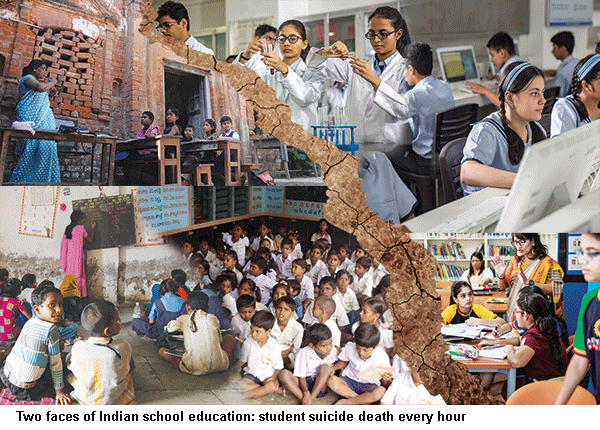
It was the best of times; it was the worst of times, it was the age of wisdom, it was the age of foolishness… it was the spring of hope; it was the winter of despair, we had everything before us, we had nothing before us — Charles Dickens (A Tale of Two Cities, 1859)
Meghana Srivastava radiates understated confidence while being interviewed by a television reporter. It is not that big a deal, but I am thrilled. A student of the Step by Step School, Noida (Uttar Pradesh), she became a national celebrity after scoring 499 out of a maximum 500 marks in the class XII school-leaving exam of the Central Board of Secondary Education (CBSE), Indias largest national examination board. Whats the secret of your success? the reporter asks. There is no secret. Hard work and consistency is the key, she responds.
Down south in Tamil Nadu’s Villupuram district, another young girl (name withheld) is in the news for a very different reason. This 17-year-old is suspected to have committed suicide after she failed to do sufficiently well in the National Eligibility-cum-Entrance Test (NEET), which determines admission into all undergraduate medical colleges countrywide. Curiously in the Plus Two exam of the Tamil Nadu School Examinations Board, she had fared brilliantly aggregating 1,125 out of a maximum possible 1,200.
The quality of school education in India is like Dickens tale of two cities. Indias 20,000-25,000 top-ranked (mainly private) schools are like 19th century London, enriched by the Industrial Revolution, shaping students filled with hope and possibility. The remaining 1.40 million are like Paris of the time, trapped in the chaos of the French Revolution, in which students suffer chronic anxiety and despair.
A minuscule fraction of the countrys 480 million children (below age 18) like Meghana, will go on to study in 200-300 top-ranked colleges and universities and secure gainful and fulfilling employment. However, the vast majority will enter the remaining 39,000 colleges and 800 universities which dispense unmindful, obsolete higher education and eventually land low-paid clerical and shopfloor employment. A student dies by suicide every hour in India, unable to fulfil her aspirations, cope with failure, or find emotional support, according to latest data of the National Crime Records Bureau. Post-independence Indias K-12 school system has repeatedly failed to deliver its promise to the countrys 250 million in-school children, the worlds largest school-going population.
Year after year, authoritative independent surveys paint a grim picture of how little children and adolescents are learning in their schools and how under-prepared they are for the future. For instance, only 40 percent of our 14-18 year-olds can calculate the price of a shirt sold at a 10 percent discount. Less than 60 percent can read the time on an analogue clock. These are the sobering findings of the Annual Status of Education Report (ASER) 2017, published earlier this year by the Pratham Education Foundation, a globally respected education NGO (estb. 1994). Even students of well-regarded private schools arent much better off. A large-scale learning benchmark survey conducted in 2014 by Educational Initiatives (EI, estb. 2001), an Ahmedabad-based assessment firm, and funded by the Michael and Susan Dell Foundation, shows that more than 40 percent of children in private high-fee schools are unable to distinguish between ‘area and ‘perimeter of a square. Their performance falls well below internationally recognised benchmarks such as the Trends in International Mathematics and Science Study (TIMSS) and the Progress in International Reading and Literacy Study (PIRLS).
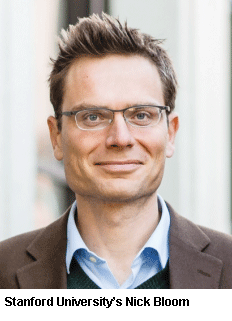 Learning outcomes in Indias schools are poor because classroom transaction is generally ineffective. Oxford University-based researcher Rhiannon Moore and her team, authors of the Young Lives School Survey (June 2018), assessed classrooms in India using a research-based observation tool. They concluded that in most observed classrooms, students do not receive enough scaffolding and feedback to encourage them to solve problems independently. Despite good discipline and time management, it appears (sic) that classroom instructional activities are therefore failing to enhance critical thinking skills and provide a meaningful learning experience.
Learning outcomes in Indias schools are poor because classroom transaction is generally ineffective. Oxford University-based researcher Rhiannon Moore and her team, authors of the Young Lives School Survey (June 2018), assessed classrooms in India using a research-based observation tool. They concluded that in most observed classrooms, students do not receive enough scaffolding and feedback to encourage them to solve problems independently. Despite good discipline and time management, it appears (sic) that classroom instructional activities are therefore failing to enhance critical thinking skills and provide a meaningful learning experience.
School management and administrative systems in India are also backward. Nick Bloom, a Stanford University researcher, has compiled data on management practices in more than 1,800 secondary schools in eight countries, including India. Assessing and benchmarking them on four critical parameters — operations, monitoring, target setting and people management — he concludes that school management practices around the world lag far behind manufacturing industries, service businesses and even hospitals. Unsurprisingly, Indian schools are at the very bottom with private schools performing marginally better than government institutions (see graphic).
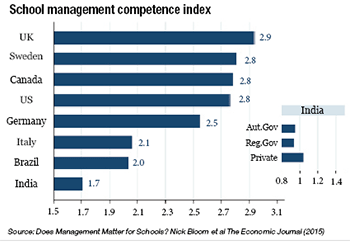 With research evidence highlighting consistently declining learning outcomes, teacher shortages, neglect of in-service teacher training and development, and a flood of media and anecdotal reports of teacher recruitment scams, chronic teacher absenteeism, widespread corporal punishment and abuse of children, theres general pessimism and gloom about school education in India.
With research evidence highlighting consistently declining learning outcomes, teacher shortages, neglect of in-service teacher training and development, and a flood of media and anecdotal reports of teacher recruitment scams, chronic teacher absenteeism, widespread corporal punishment and abuse of children, theres general pessimism and gloom about school education in India.
However, as educators whose job is to spark the light of learning in children and youth in our care, a pragmatic approach is to become learners ourselves. School leaders and teachers have much to learn from the outside world about how to change our schools for the better. Study of high-performing schools around the world can offer useful pointers on how to reform, revitalise and rejuvenate Indias 1.52 million schools — not just 1.20 million government schools but private as well — which are shortchanging the worlds largest and high potential child population, and indeed the national development effort.
Lucy Crehan, a British educator and author of Cleverlands: The Secrets Behind the Success of the Worlds Education Superpowers (2016), spent two years inside classrooms in Finland, Canada, Japan, China, and Singapore — countries which routinely top the PISA (Programme for International Student Assessment) league table published every three years. She found that despite contextual and cultural differences, schools in these high-performing countries have surprising commonalities. They focus on ensuring that children master core concepts, are motivated to learn and encouraged to take on challenges. They also respect teachers as professionals and support them by way of continuous training and development programmes and enabling infrastructure.
Another example closer to home, is of the Republic of Vietnam (pop. 92.7 million) which emerged from a bloody civil war in the late 1970s and has become a remarkable education success story. In 2015, its 15-year-olds participating in PISA for the first time, outscored peers from many developed countries in reading, math and science. An analysis of the Education Development Trust (a London-based think tank) indicates the driving factors behind Vietnams students are contemporary curriculum, teacher support, principals focused on institutional development and high parent engagement. According to the analysis, Vietnams education ministry drew heavily from the Escuela Nueva programme of Colombia which has initiated far-reaching reforms by switching to student-centric pedagogies, support materials for teachers, and improved institutional management. In the age of instant digital connectivity and globalisation, it is possible — and necessary — for educationists in vastly different geographies to identify and adapt best practices in education.
Therefore, what lessons can Indias educationists and educators draw from these global success stories? We can make a start by implementing three actionable insights to repair the severely damaged foundations of post-independence Indias K-12 education system, especially government schools.
• First, redesign curriculums and the examination system which encourage and reward rote learning and memorisation capabilities, to promote and reward critical thinking and problem-solving skills
• Second, stop blaming teachers; start improving teaching by equipping teachers with well-researched tools and practical training
• Third, develop a new cadre of non-bureaucratic education leaders who invest time and effort in institution development
1. Skill-focused curriculum and assessment
21st-century curriculums should equip students with skills to critically analyse information and apply knowledge creatively to solve real-world problems, communicate solutions and collaborate with peers and publics. Moreover in this new era of accelerated global warming and imminent environment disaster, they should teach children the basic principles of sustainable development. Examination systems should test and reward these skills and capabilities.
Unfortunately across the education continuum, Indias students are encouraged to develop rote learning and memorisation capabilities. The tradition of encouraging textbooks-centred learning so children can memorise printed information, is hard-wired into our teaching-learning systems. Consequently, school-leavers and college graduates are ill-equipped to meet the demand for complex analytical, critical thinking and problem-solving skills required in modern workplaces.
Adults who lack these skills are certain to experience difficulty in finding well-paid and fulfilling employment in the worlds fast-changing homogenising economies. Jobs that require repetitive procedures such as accounting, assembly line manufacturing and even low-end software programming are declining. Simultaneously, demand for people equipped with non-routine, analytical and interpersonal skills is rising steadily in the US (and industrially advanced countries), according to MIT and World Bank researchers (see graphic p.52). Although robotics technology and artificial intelligence are getting better at doing routine manual jobs and resolving complex problems, they are a long way from replicating human capabilities such as advanced communication and negotiation, empathy and people management. Therefore, 21st-century school curriculums need to consciously teach soft skills such as communication, negotiation, compassion, collaboration and teamwork and ethnic and cultural tolerance, which are becoming increasingly important in the fast-crystallising global marketplace.
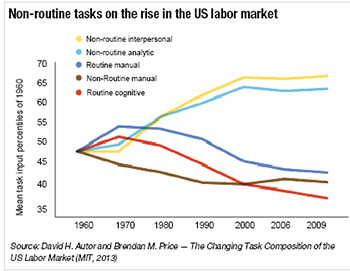 Consequently its high time that Union human resource development ministry officials, educationists, promoters, principals and teachers in 21st century Indias K-12 education system start preparing our children for success in the modern world. Tony Wagner, former co-director of the Change Leadership Group at the Harvard Graduate School of Education and author of the best-selling Most Likely to Succeed: Preparing our Kids for the Innovation Era (2015), comments: The world doesnt care what you know. What the world cares about is what you do with what you know. Now, adults need to be able to ask great questions, critically analyse information, form independent opinions, collaborate and communicate effectively. These are the skills essential for both career and citizenship.
Consequently its high time that Union human resource development ministry officials, educationists, promoters, principals and teachers in 21st century Indias K-12 education system start preparing our children for success in the modern world. Tony Wagner, former co-director of the Change Leadership Group at the Harvard Graduate School of Education and author of the best-selling Most Likely to Succeed: Preparing our Kids for the Innovation Era (2015), comments: The world doesnt care what you know. What the world cares about is what you do with what you know. Now, adults need to be able to ask great questions, critically analyse information, form independent opinions, collaborate and communicate effectively. These are the skills essential for both career and citizenship.
Traditional educationists argue that basic literacy, numeracy and content knowledge must not be overlooked in a mad rush to teach so-called 21st-century skills. Liberals also warn that narrow focus on education for employability comes at the cost of educations broader humanistic purposes. In my opinion, these forced distinctions between knowledge versus skills or skills versus character development, are false dichotomies. Its incontrovertible that teaching generic problem-solving skills without developing content knowledge and vice-versa is self-defeating. A solid foundation of basic numeracy, literacy and science is the necessary foundation for developing higher-order skills such as critical thinking and analytical problem-solving. However, success in 21st-century workplaces needs a broader range of capabilities as well, including soft skills such as communication, teamwork and people management.
2. Pragmatic teacher preparation
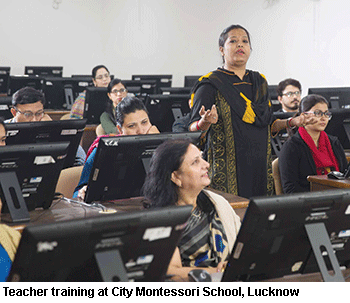 A significant cause of poor learning outcomes in Indias schools is prolonged neglect of professional development of the countrys 9 million K-12 teachers. Practitioners and knowledgeable monitors of the education system are almost unanimous that the nations 16,000-plus teacher training and development colleges — 90 percent privately promoted institutions — are a little more than teaching shops dispensing obsolete, theory-heavy training with little relevance to the classroom. No wonder the B.Ed certificates they vend have no real value.
A significant cause of poor learning outcomes in Indias schools is prolonged neglect of professional development of the countrys 9 million K-12 teachers. Practitioners and knowledgeable monitors of the education system are almost unanimous that the nations 16,000-plus teacher training and development colleges — 90 percent privately promoted institutions — are a little more than teaching shops dispensing obsolete, theory-heavy training with little relevance to the classroom. No wonder the B.Ed certificates they vend have no real value.
Most debates about teaching in India centre around two competing narratives — bad and good teachers. The former are categorised as incompetent, under-motivated, and delinquent. The good teacher is depicted as hardworking, committed and heroic, slaving within an unrewarding system. However, the reality is that teachers are neither bad nor good. It is their teaching that is either effective or ineffective.
Therefore, instead of obsessing about the character of teachers, we should take three pragmatic steps to introduce ‘good teaching in every classroom by equipping every teacher with a detailed learning process, well-researched curricular tools, and continuous classroom coaching. Primarily, we need a scientific ‘formula for good teaching. Consider a step-by-step approach to teach every concept where students are clear about the lessons objective, conduct hands-on activity to experience it, analyse it deeply by questioning, apply their knowledge to solve a real-life challenge, and are assessed on what they have learned. For this, we need to equip every teacher with a practical ‘classroom toolkit that can help her succeed in the classroom every day. When teachers go into their class equipped with advanced learning aids and researched teaching plans, they know precisely how to introduce concepts, conduct purposeful activities, and ask probing questions. Finally, showing works better than telling in all learning, including learning how to teach. Teaching skills improve when teacher-coaches demonstrate effective lessons, observe how teachers work, share actionable feedback and offer practical advice on engaging children.
Unfortunately, ideological confusion has held back the large-scale adoption of such pragmatic approaches to teacher preparation. Some critics argue that good teaching is an art that defies precise definition. Others contend that structured teaching plans straightjacket teachers creativity. Moreover, many believe the more extended the teacher training, the better. Research proves otherwise.
There is a vast body of research and anecdotal evidence mainly from — admittedly sparsely populated — Scandinavian and East Asian countries which indicates that with advanced pedagogical tools and continuous classroom-based professional development programmes, teachers can — and do — consistently perform better in classrooms.
In her highly acclaimed book Cleverlands, Lucy Crehan notes that even in Finland, globally renowned for creative classroom transactions, teachers use carefully prepared teaching guides for lessons, which enable superior teacher-pupil engagement. A 2018 research study in South Africa conducted by Jacobus Cilliers, assistant professor of public policy at Georgetown University, USA and his colleagues, shows teachers who received classroom-based coaching and used detailed lesson plans had double the impact on student outcomes compared to teachers who received training in conventional training workshops.
We must start by training our teachers with the rigour invested in training other professionals. A teacher needs a clear understanding of the teaching learning process like a lawyer needs to be well acquainted with the Constitution of India. Teachers must draw on well-researched pedagogical processes to teach concepts just like a surgeon walks through a step-by-step checklist to treat a trauma wound. A teacher imbibes classroom demos by experts in the same way a musician learns by watching experts perform.
3. Developing instructional leaders
 Curiously, conscious development of school leaders equipped with a combination of pedagogic knowledge, enabling technology and administrative and institution building skills has been a blindspot of K-12 education in India. Typically, school principals tend to be promoted teachers with long service records and minimal awareness of marketing, fund-raising, human resource development and brand-building skills.
Curiously, conscious development of school leaders equipped with a combination of pedagogic knowledge, enabling technology and administrative and institution building skills has been a blindspot of K-12 education in India. Typically, school principals tend to be promoted teachers with long service records and minimal awareness of marketing, fund-raising, human resource development and brand-building skills.
Consequently there is a critical shortage of leadership talent in Indias schools. In the same manner as lateral entry of business professionals into the Indian Administrative Service has been green-lighted by the Union government, a process of induction of industry and business professionals with organisation management and development skills into the school — and higher education — sector needs to be encouraged by government, private school promoters and governing boards. I am confident there wont be a shortage of industry professionals willing and able to sign short-term contracts to serve in public and private schools. Most principals in Indias schools are trapped inside their offices coping with strangulating government regulations, examination boards paperwork, and day-to-day administration with little time or energy to monitor what happens inside their classrooms and teachers common rooms.
Meanwhile, until this engagement between education and industry blooms, governments, school affiliation boards and private school promoters need to encourage principals and headmasters to step out of their offices to invest more time inside classrooms and staffrooms. Every school leader must develop a hands-on understanding of effective teaching techniques and keep abreast of the latest pedagogies and technologies to continuously improve students learning outcomes. Such institutional leaders appreciate childrens learning needs and prioritise them over adult conveniences in allocating resources. Equipped with understanding of contemporary teaching-learning practices, they need to recruit the best talent and make the time to supervise the professional development of their teachers and staff.
Principals with classroom experience deliver better student outcomes. In a research study conducted by Roland Fryer, professor of economics at Harvard University, a selected group of school principals were taught how to introduce lesson planning, data-driven instruction and establish a classroom observations feedback system (using a six-step protocol designed by Paul Bambrick-Santoyo). Principals in this group improved student learning outcomes in their schools by 7 percent within one year.
Therefore, the worlds best-performing school systems are investing heavily in school leadership development programmes. For instance, most K-12 schools in Singapore, whose students are routinely ranked among the Top 5 national cohorts who write PISA every three years, provide a unique ‘leadership track for innovative leader-teachers and assign them specific responsibilities for whole school improvement. In Shanghai as well, aspiring principals receive extensive curriculum design and in-service institution leadership training.
Sceptics contend that unless there are radical shifts in government policy, schools cannot introduce meaningful school reform initiatives suo motu. However, while it is undeniable that overhaul of old policies governing syllabi, examinations, teacher certification and school regulation is helpful, macro education reforms are not a precondition of school improvement programmes which can dramatically improve learning outcomes in K-12 education. Learning outcomes in schools within the same socio-economic strata vary widely because of choices leaders and teachers make. Teachers can, and do, decide how to introduce a concept, what activities to choose, and what questions to pose to children to assess their comprehension. Similarly, school principals can, and do, decide how much time they spend in classrooms observation and in teacher training and development programmes. Those decisions make a big difference in how well children learn.
Many educationists believe that organisation restructuring and innovation is the privilege of well-resourced high-end schools earning substantial tuition fees incomes. This belief is misplaced. Rote learning used to be the norm in over 3,000 mainstream schools before they implemented the XSEED teaching methodology and whole school change management programme. Located mostly in small towns, these schools are constrained by inadequate infrastructure, state-mandated syllabuses and under-trained local teachers. However, today over 1 million children in these schools absorb concepts through experiential learning, free exchange of ideas and analytical questioning. They apply theoretical knowledge to solve challenging real-life problems and get assessed on their skills. As a result, they fare better in examinations, communicate with confidence and are ready to derive the full benefit of higher education which presages success in increasingly complex workplaces of the 21st century.
Every child in India, whether in Noida or Villupuram, deserves good quality globally comparable education. Therefore, every school, elite or affordable, must strive to deliver this implicit promise of educational institutions and teachers. The three stepping stones of school education reform — redesigned curriculums, improved teacher training and development programmes, and conscious development of instructional leaders — is an excellent way to start the process of delivering this mostly unfulfilled promise to Indias neglected but high-potential children.
Make every student innovations ready
 Anustup Nayak interviewed Tony Wagner, senior research fellow at the Learning Policy Institute, Palo Alto, California. Earlier, Wagner served as faculty at Harvard University for over two decades, including four years as expert-in-residence at the Harvard Innovation Lab. He has also authored the best-seller The Global Achievement Gap (2008) and Most Likely to Succeed: Preparing our Kids for the Innovation Era (2015).
Anustup Nayak interviewed Tony Wagner, senior research fellow at the Learning Policy Institute, Palo Alto, California. Earlier, Wagner served as faculty at Harvard University for over two decades, including four years as expert-in-residence at the Harvard Innovation Lab. He has also authored the best-seller The Global Achievement Gap (2008) and Most Likely to Succeed: Preparing our Kids for the Innovation Era (2015).
What should be the goals of a modern education?
The goal of education today should not be to make every student workplace ready but innovations ready — equipped to add value to whatever they do. Today, because knowledge is available on every Internet-connected device, what you know matters far less than what you can do with what you know.
Are current schooling systems geared to deliver this goal?
More than a century ago, we reinvented the one-room schoolhouse and later created factory schools for the industrial economy. We teach and test things in which most students have no interest and will never need, and facts that they can Google and will forget as soon as a test is over. Because of this, the longer kids are in school, the less motivated they become.
Therefore, what must 21st century schools teach?
Of course, every young person will continue to need basic knowledge. However, capability to innovate — to solve problems creatively and bring new possibilities to life — skills like critical thinking, communication and collaboration are far more important than academic knowledge. Young people who are intrinsically motivated — curious, persistent, and willing to take risks — will learn new knowledge and skills continuously. They will be able to find new opportunities or create their own — a disposition that will become increasingly important as many traditional careers disappear.
In the circumstances, assessment systems also need to change…
Students grades in a particular class are supposed to represent how well they served that time, and students grade point average and class rank are taken as measures of how well they have performed compared to their peers. These numbers still make up the typical high school transcript. But such assessment metrics are more than a century old, and hopelessly obsolete.
There is a better way. Some of Americas leading independent schools have announced the promotion of a Mastery Transcript Consortium (MTC). This is an initiative to create entirely new ways to assess and report the quality of student work based on real evidence of mastery, rather than a grade or time spent in a particular class. MTC will indicate the skills and knowledge that students have mastered and will also assess qualities of character that make their humanity visible.
What do these assessment system changes imply for teachers and principals?
Teachers need to inspire and lead students towards performance excellence, and principals must evolve into leaders who create institutional cultures of collaboration which is the precondition of innovation.
Teachers should learn from each other
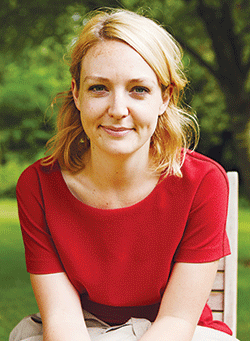 An education postgrad of Cambridge University, Lucy Crehan — the author of Cleverlands: The Secrets Behind the Success of the Worlds Education Superpowers (2016) — spent two years observing classrooms in Finland, Canada, Japan, China and Singapore.
An education postgrad of Cambridge University, Lucy Crehan — the author of Cleverlands: The Secrets Behind the Success of the Worlds Education Superpowers (2016) — spent two years observing classrooms in Finland, Canada, Japan, China and Singapore.
In spite of cultural differences between academically high-performing countries, what similarities are there in learning environments structured for children?
In my experience, all high performing school systems have five important commonalities. First, they invest in getting children ready for formal education by making pre-schooling available to all children. Second, they design curricular content for mastery by all children and create motivating classroom environments.
The State mandates what content is to be taught, but gives flexibility to teachers to choose appropriate examples relating to childrens lives. Third, they support all children to master the curriculum, providing additional support to low-performing students without lowering standards. Fourth, they treat teachers as professionals. Every teacher masters a standard body of knowledge, follows research-based practices and progresses up a professional career development ladder. Finally, schools are held accountable for providing professional support.
In Cleverlands, you commend teachers who teach mathematical concepts by linking them with real-world problems. Can you give an example of how this pedagogy works better than the traditional approach?
In Japan, teachers focus on getting the children to know why are we learning this? For example, if a teacher has to teach bar charts, she would say, I have some containers. Can you tell me how much water each holds? The teacher draws a bar chart to represent each jar corresponding to its volume of water. Therefore, children easily understand how bar charts aid in representing measurements of real-world objects.
Could you provide some examples of how school systems of high performing countries design their in-school teacher preparation programmes?
In the school systems of high performing countries, professional development is accelerated by a culture of teachers learning from each other. One useful practice is allocating one period every week in which teachers plan lessons together, reflect on the previous weeks practice, and brainstorm on how to improve teaching. In addition, they are allocated time every four-to-six weeks for lesson planning study, where all teachers plan one lesson in great detail. Finally, there are classroom demos during which one teacher teaches students and others observe how children are learning. This is followed by reflection sessions and tweaking lessons for the future.
You highlight that in Finland, a country known for selectivity and rigour in pre-service teacher training, teachers are given teaching guides and lesson schedules. How does this impact autonomy and effectiveness?
In Finland, students textbooks have specific teacher guidelines which are used by teachers to plan their lessons. They usually contain lesson plan suggestions, examples, assignment options, group work topics, number-of-lessons-per-topic suggestions etc. When I asked teachers whether these guides curtail their autonomy and creativity, they answered in the negative. These guidelines contain the tested wisdom of experienced teachers. So why not make use of the saved planning time to think about how to make lessons more exciting? said one of them
(The author is an alumnus of the Harvard Graduate School of Education and vice president of XSEED Education)















Add comment